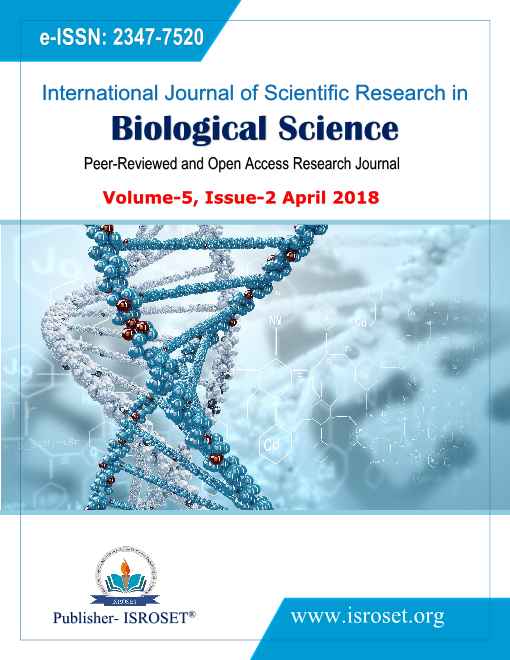Antibacterial activities of wild rhizomatous plants - Curcuma aromatica, Curcuma longa (Zingiberaceae) and synergistic effects of both collected from southern Western Ghats, India
Keywords:
Antibacterial activity, Curcuma aromatica, Curcuma longa, Western GhatsAbstract
Rhizome extracts of Curcuma aromatica and Curcuma longa (Zingiberaceae) from southern Western Ghats of Tamil Nadu, India were investigated for their antibacterial activity by agar well diffusion method against bacterial human pathogens such as Escherichia coli, β-haemo streptococci, Klebsiella penumoniae, Staphylococcus aureus, Salmonella typhi, Bacillus subtilis and Pseudomonas aeruginosa. The study revealed that except Pseudomonas aeruginosa, all the pathogens were inhibited by various extracts (Methanol, Ethanol, n-Butanol and Acetone) of Curcuma spp. sometimes far better than the control antibiotic Amoxicillin. Pseudomonas aeruginosa was inhibited by n-Butanol extract of C. longa as equal as standard antibiotic. These results clearly elucidates that Curcuma aromatica and Curcuma longa collected from wild have higher antibacterial activity than that of standard antibiotic.
References
I. Chattopadhyay, K. Biswas, U. Bandyopadhyay, R.K. Banerjee, “Turmeric and curcumin: Biological actions and medicinal applications”, Curr. Sci., Vol.87, pp.44-53, 2004.
T. Rudrappa, H.P. Bais, “Curcumin, a known phenolic from Curcuma longa, attenuates the virulence of Pseudomonas aeruginosa PAO1 in whole plant and animal pathogenicity models”, Journal of Agriculture and Food Chemistry, Vol.56, pp.1955-1962, 2008.
A.E. Mohamed, A.F. Abdel-Aziz, E. M. El-Sherbiny, R.M. Mors, “Anti-diabetic effect of Aloe vera juice and evaluation of thyroid function in female diabetic rats”, Bioscience Research, Vol.6, pp.28-34, 2009.
I.S. Villagas, S. Fidalgo, L.C. Alacon, “New mechanisms and therapeutic potential of curcumin for colorectal cancer”, Molecular Nutrition and Food Research, Vol.52, pp.1040-1061, 2008.
S.A. Antunes, S.R. Weber, L. Schittler, G.A. Gomes, “Synergistic and antimicrobial properties of commercial turmeric (Curcuma longa) essential oil against pathogenic bacteria”, Ciênc Tecnology Aliment Campinas, Vol.32, pp.525-530, 2012.
A. Apisariyakul, N. Vanitanakom, D. Bunddhasukh, “Antifungal activity of turmeric oil extracted from Curcuma longa”, Journal of Ethanopharmacology, Vol.49, pp.163-169, 1995.
A.K. Tripathi, V. Prajapati, N. Verma, J.R. Bahl, R.P. Bansal, S.P.S. Khanuja, S. Kumar, “Bioactivities of the leaf essential oil of Curcuma longa (var. Ch-66) on three species of stored-product beetles (Coleoptera)”, Journal of Economics Entomology, Vol.95, pp.183-189, 2002.
A. Parvin, J. Akter, M.M. Hassan, N. Biswas, “Study on the comparative antibacterial activity of Polyalthia longifolia (Debdaru) leaf extracts to some selective pathogenic bacterial strains”, International Journal of Biosciences, Vol.3, pp.17-24, 2013.
M.A. Morshed, A. Uddin, R. Saifur, A. Barua, A. Haque, “Evaluation of Antimicrobial and Cytotoxic properties of Leucas aspera and Spilanthes paniculata”, International Journal of Biosciences, Vol.1, pp.7-16, 2011.
N. Fayzunnessa, M.A. Morshed, A. Uddin, A. Parvin, R. Saifur, “In vivo study on the efficacy of hypoglycemic activity of Spirulina plantesis in long evan rats”, International Journal of Biomolecules and Biomedicine, Vol.1, pp.27-36, 2011.
H.J.D. Dorman, S.G. Deans, “Antimicrobial agents from plants: antibacterial activity of plant volatile oils”, Journal of Applied Microbiology, Vol.88, pp.308-316, 2000.
N. Sharma, “Antibacterial Activity of Fresh Juices of Lemon, Onion, Bottle Gourd and Tomato Against Multiple Drug Resistant Bacteria such as E. Coli, Staphylococcus, Bacillus, Klebsiella and Salmonella”, International Journal of Scientific Research in Biological Sciences, Vol.2, Issue.2, pp.16-20, 2015.
J.P. Robinson, V. Balakrishnan, J.S. Raj, S.J. Britto, “Antimicrobial activity of Alpinia calcarata Rosc. and characterization of new , unsaturated carbonyl compound”, Advances in Biological Research, Vol.3, Issue.5-6, pp.184-187, 2009.
R. Harikrishnan, C.N. Rani, C. Balasundaram, “Hematological and biochemical parameters in common carp, Cyprinus carpio, following herbal treatment for Aeromonas hydrophila infection”, Aquaculture, Vol.221, pp.41-50, 2003.
T. Baytop, “Therapy with medicinal plants in Turkey (past and present)”, Istanbul University, 1984.
P.C. Allen, H.D. Danforth, P.C. Augustine, “Dietary modulation of avian coccidiosis”, Int. J. Paracitol. Vol.28, Issue.7, pp.1131- 1140, 1998.
S. Naz, S. Jabeen, S. Ilyas, F. Manzoor, F. Aslam, A. Ali, “Antibacterial activity of curcuma longa varieties against different strains of bacteria”, Pak. J. Bot., Vol.42, Issue.1, pp.455-462, 2010.
N. Chainani-Wu, “Safety and anti-inflammatory activity of curcumin: a component of turmeric (Curcuma longa)”, J. Altern. Complement Med., Vol.9, pp.161-168, 2003.
H.A. Vogel, J. Pelletier “Chemische Untersuchung der Gilbwurzel (Kurkume)”, J. Pharma. Vol.7, pp.20, 1815.
P.J. Roughley, A. Donald, D.A. Whiting, “Experiments in the biosynthesis of curcumin”, J. Chem. Soc., Perkin Trans., Vol.1, pp.2379-2388, 1973.
H. Chandarana, S. Baluja, S.V. Chanda, “Comparison of antibacterial activities of selected species of Zingiberaceae family and some synthetic compounds”, Tur. J. Biol., Vol.29, 83-97, pp.2005.
K. Paech, M.V. Tracey, “Modern Methods of Plant Analysis”, Springer Verlag, Berlin, vol. III, pp. 626-654, 1995.
F. Payton, P. Sandusky, W.L. Alworth, “NMR study of the solution structure of curcumin”, J. Nat.Prod., Vol.70 Issue.2, pp.143-146, 2007.
J. Joshi, S. Ghaisas, A. Vaidya, R. Vaidya, D.V. Kamat, A.N. Bhagwat, S. Bhide, “Early human safety study of turmeric oil (Curcuma longa oil) administered orally in healthy volunteers”, J. Assoc. Physicians India, Vol.51, pp.1055-1060, 2003.
P. Chirangini, G.J. Sharma, S.K. Sinha, “Sulfur free radical reactivity with curcumin as reference for evaluating antioxidant properties of medicinal Zingiberales”,. Journal of Environnemental Pathology, Toxicology and Oncology, Vol.23, pp.227-236, 2004.
I. Ahmad, Z. Mehmood, F. Mohammad, “Screening of some Indian medicinal plants for their antimicrobial properties”, J. Ethnopharmacol., Vol.62, pp.183-193, 1998.
N. Gul, T.Y. Mujahid, N. Jehan, S. Ahmad, “Studies on the antibacterial affect of different fractions of Curcuma longa against Urinary tract Infection isolates”, Pakistan J. Biol. Sceinces, Vol.7, Issue.12, pp.2055-2060, 2004.
R. Singh, R. Chandra, M. Bose, P.M. Luthra, “Antibacterial activity of Curcuma longa rhizome extract on pathogenic bacteria”, Current Science, Vol.83, Issue.6, pp.737-740, 2002.
A.R. Srividya, A.K. Yadav, S.P. Dhanabal, “Antioxidant and Antimicrobial Activity of Rhizome of Curcuma aromatica and Curcuma zeodaria, Leaves of Abutilon indicum”, Archives of Pharmaceutical Sciences and Research, Vol.1, Issue.1, pp.14-19, 2009.
Downloads
Published
How to Cite
Issue
Section
License

This work is licensed under a Creative Commons Attribution 4.0 International License.
Authors contributing to this journal agree to publish their articles under the Creative Commons Attribution 4.0 International License, allowing third parties to share their work (copy, distribute, transmit) and to adapt it, under the condition that the authors are given credit and that in the event of reuse or distribution, the terms of this license are made clear.







